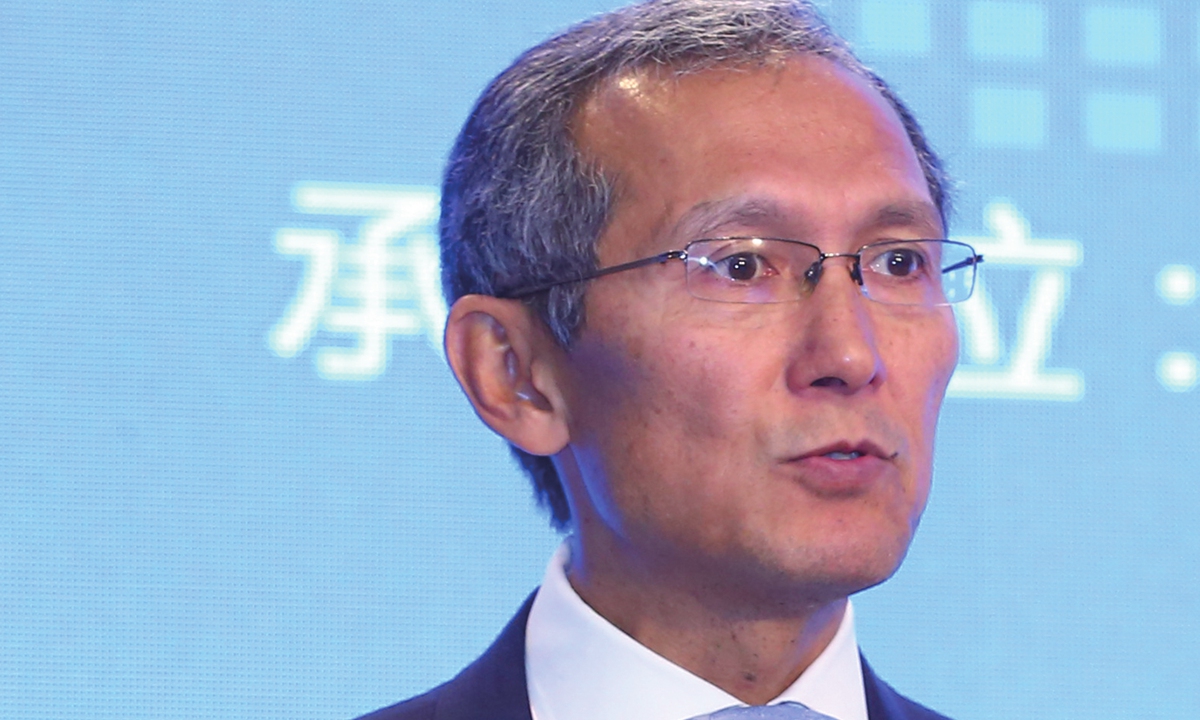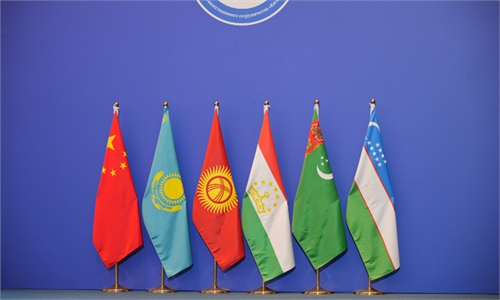Central Asians seek deeper involvement in China's modernization, high-quality development: former Kyrgyzstani PM

A building in Xi'an with lights celebrating the upcoming China-Central Asia Summit. Photo: VCG
Editor's Note:The China-Central Asia Summit will be held in Xi'an, Northwest China's Shaanxi Province, from May 18 to 19, and will be the first major diplomatic activity that China hosts this year, as well as the first summit held offline by the heads of state of the six countries since the establishment of diplomatic ties 31 years ago. Why are China-Central Asia relations enhancing? What is the basis of this development? What should be the main focus of the cooperation between the two sides in the next stage? Djoomart Otorbaev (Otorbaev), former prime minister of the Kyrgyz Republic and a Non-resident Senior Fellow of Chongyang Institute for Financial Studies, Renmin University of China (RDCY), discussed these issues with Global Times (GT) reporter Xia Wenxin.
GT: What are your expectations for the China-Central Asia Summit? What role will this event play in promoting China-Central Asia relations?
Otorbaev: Last month, foreign ministers of China and five Central Asia countries had a meeting in Xi'an, and they discussed what would be on the agenda of the summit. All details of discussions and agreements will only be revealed during the summit itself, but from what we heard now from officials from different sources, it will be quite a historic meeting, as China and Central Asian countries are under preparation at full speed to go to the qualitatively new level of communication. So I expect that countries will be confirming their political goodwill to work together, to bring the relationship to a new phase, to fight together against terrorism, extremism, and illegal migration, to care about security in our region, to ease barriers to making business, and to increase the people-to-people exchanges between our region and China.
Moreover, it is clearly seen that the railroad between China, Kyrgyzstan and Uzbekistan will be receiving a new momentum at the summit. We heard that Chinese engineers and financiers are making a bankable feasibility study for this railroad. If it happens, then the distance between China and Europe will be shortened by another 900 kilometers. And participants of the agreement feel that it's feasible. So this construction will bring the fruits to all participants.
GT: Last year marked the 30th anniversary of establishing diplomatic relations between China and the five Central Asian countries. How do you view the cooperation between China and Central Asia in the past three decades?
Otorbaev: I think that during the 30 years of our diplomatic relationships, the key is that we established trust between our countries. We work continuously with each other without any problems. In 2022, the volume of trade between China and countries of Central Asia exceeded $70 billion. During 30 years since the establishment of diplomatic relations, the trade volume increased 100 times, quite a dramatic increase.
Moreover, China invested in the countries of Central Asia around $15 billion in different projects. For the biggest of them, I would name the crude oil pipeline from Kazakhstan to China, as well as the natural gas pipeline between Turkmenistan and China. It means that China got a lot of hydrocarbons from Central Asia, and this cooperation will continue.
Besides this, transport infrastructure has also been established. For example, a very efficient railroad between China and Kazakhstan has been opened. Two highways have been built between China and Kyrgyzstan, and a lot of trade is going on between countries along those highways.
So the time was not wasted: We understand each other better and the structures of our economy better. On our horizons, we have much more ambitious projects between each other. And what's happening is that now we're going to go to the next step of our cooperation.

Djoomart Otorbaev Photo: RDCY
GT: Why can China-Central Asia relations keep growing and upgrading? What is the basis for the deepening of the bilateral relationship?Otorbaev: Geographically, we are very close to each other. For centuries, our ancestors traded and made friends with each other. So we have known each other for a long time. From the perspective of our countries, we have to work hard to increase economic activities with China, which is a booming economy. So we have to use all opportunities which China could provide as a trading partner and investor to infrastructure, different enterprises, factories and plants. We will be working together to increase exports and imports between the countries.
We know about the China-launched Global Development Initiative and Global Security Initiative. We also want to be part of these global initiatives so that the region will be more harmonious with security, peace, and mutually beneficial activities together. We want that all kinds of links will be established, from energy to transportation to people-to-people exchanges. And through a mutually beneficial exchange of goods, we will continue to build trust between our nations. With emerging China and Central Asia, we see the huge potential for strengthening our nations.
GT: How do you see China's success in terms of economic and technological development? Can Chinese modernization benefit Central Asian countries as well?
Otorbaev: In order to increase GDP, China now needs to drastically improve its productivity. And productivity will be improved by using new technologies. This is exactly what is happening in most advanced Western countries, where they also emphasize development and high-quality economy on modernization.
China is doing quite well in competition with the West. And what I know is that based on the report of an Australian think tank, out of the most important 44 directions of modernization, China already got the first place in 37, only seven left where the West held superiority. So it's very dramatic and tremendously important, in fact. But China is not recently moving into this modernization. The decision was made many years ago. And now not only do we hear a message of the desire, we see results. In most areas, China is already a champion in innovation and discoveries.
What I would like to underline is that now China really has to focus on fundamental research and bring the results of that research into the applications. And we Central Asians want not only to be observers of this process of modernization, but also to be part of it. So my suggestion for Central Asia's modernization would be to cooperate with China in the modernization drive. We will work together in some scientific centers to generate new ideas to generate and produce high-quality ideas and products. It's very important that we have a big appetite to be together with China and high-quality development as countries with highly educated populations.
GT: This year marks the 10th anniversary since Chinese President Xi Jinping proposed the initiative of the "Silk Road Economic Belt" (the Belt) in Kazakhstan of Central Asia. How do you see the impact of the Belt and Road Initiative (BRI), particularly the Belt, on the region over the last decade? How has the China-Central Asia relationship been enhanced under this initiative?
Otorbaev: The fact that Xi proposed the concept of the Belt in Central Asia was a conscious step that indicated that the region would be the testing ground for the BRI. From that time, the initiative became really global. Now, more than 100 countries are part of this initiative. For the first time in history, China wanted to cooperate and make business, investments, and trade with all countries on our planet. And, of course, if you are neighbors, you are first to see each other, especially since we have known each other for centuries.
During these 10 years, indeed, many things have happened. High-quality development is also coming to our soils, not only in natural resources investment, but also in all other areas that we started to cooperate. During that time, we signed hundreds of agreements on trade, investment and on increasing mutual trust. What we are looking for is to be together with China in its way of high-quality development.
GT: Some Western media have called the China-Central Asia summit an attempt from China to "compete with Russia and undermine its presence in the region." What is your take on this?
Otorbaev: It's a conspiracy theory. I don't really believe that this is happening. There is a conspiracy theory about the so-called zero-sum game in which if China wins, Russia loses. It is wrong, because Central Asia's engagement with China and Russia will always be a win-win-win situation.
Both China and Russia, as well as the rest of the world, want to see Central Asia as a prosperous and progressive element, but not an element of poverty and hunger. So if Central Asia develops quicker and becomes healthier and richer, all neighbors will benefit. Nobody wants to see Central Asia as a source of illegal migration, terrorism, extremism and so on. So in that respect, Russia and China have the same ideas. There is no competition.
Everybody from China, Russia and Central Asia will benefit from the healthy cooperation. And there is no limit to cooperation, because we are in between [China and Russia] and we can transit and trade with each other. It is mutually beneficiary because we complement each other. We will be good neighbors, good friends and good partners.
GT: Your new book Central Asia's Economic Rebirth in the Shadow of the New Game was published earlier this year. Could you please tell us what this book is about?
Otorbaev: The main goal of the book is to describe the current political and economic situation in the countries of Central Asia, and to show the outside world what happened last 30 years, how these countries survived the difficult transition period from independence to current days, what are the main priorities in economic development and what are the lives of people and social situation. In my book, I'm trying to note that Central Asia looks like a uniform area after many years, which can present itself not as five different, not cooperating countries, but as one region. I also try to place Central Asia on the map of the world. This is my main goal.

